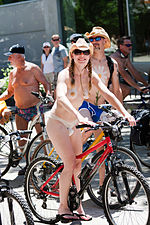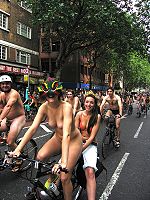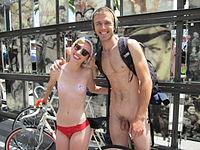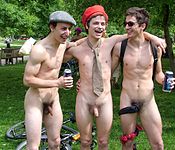- World Naked Bike Ride
-
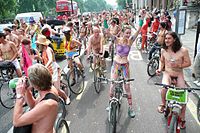 Participants in the 2007 World Naked Bike Ride in London
Participants in the 2007 World Naked Bike Ride in London
World Naked Bike Ride (WNBR) is an international clothing-optional bike ride in which participants plan, meet and ride together en masse on human-powered transport (the vast majority on bicycles, but some on skateboards and inline skates), to "deliver a vision of a cleaner, safer, body-positive world."[1]
The dress code motto is "Bare as you dare".[2] Full and partial nudity is encouraged, but not mandatory, on all rides. Any mandate to cover intimate parts is forbidden; this is a distinguishing feature of WNBR against other cycling events.
Creative expression is also encouraged to generate a fun and immersive atmosphere during the ride, capture the attention and imagination of the public and media, and make the experience more personalized and fulfilling for the riders. Body art, such as body painting, are common forms of creative expression, as well as costumes, art bikes, portable sound reinforcement systems (such as public address systems, bullhorns and boomboxes) and musical instruments or other types of noisemaker.
Pre- and post-ride parties for WNBR have become events unto themselves, often featuring musical bands, DJs, body painting, temporary structures/installation art, political tabling, and catering. In addition to simply being able to ride clothes-free on community streets, some rides have established precedent by having body-painting parties, often involving numbers of naked riders and artists in high-visibility municipal parks.
This distinctive form of Critical Mass, occasionally called Critical Ass in a WNBR context, is often described or categorised as a form of political protest, street theatre, party-on-wheels, streaking, public nudity and clothing-optional recreation, and thus attracts a wide-range of participants.
Contents
History
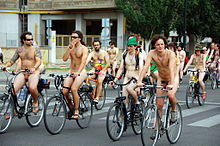 Zaragoza hosted the first NBR. Pictured are participants in the 2009 WNBR in the Spanish city.
Zaragoza hosted the first NBR. Pictured are participants in the 2009 WNBR in the Spanish city.
Prior to the World Naked Bike ride in 2004 there were many organizations organizing naked bike rides. In Germany naked bike rides were regularly organized by FKK organizations (Freie Körper Kultur). In Seattle naked bike rides were organized by the Fremont riders. In Spain rides were organized by the Ciclonudista. In Canada naked rides were regularly organized by Artists Against War.
In 2003 Conrad Schmidt conceived the World Naked Bike Ride after organising the Naked Bike Rides of the group Artists for Peace/Artists Against War (AFP/AAW)[3] which took place in the early part of the same year, as well as other high-profile political and media events leading to the creation of the Work Less Party of British Columbia.
WNBR rapidly started to come to life through collaborations with activist groups and individuals around the world. The first WNBR event in 2004 was a collaboration between the WNBR group (riding on 12 June) and Manifestación Ciclonudista in Spain (riding on 19 June), establishing a precedent as a solstitial Saturday observance. Since that time rides have also taken place in February and March (mainly in the Southern Hemisphere). A smaller number of rides have taken place at other times of the year.
Prior to the first World Naked Bike Ride event in June 2004, two independent organizations — AFP/AAW and Manifestación Ciclonudista — had been organising very similar political events with virtually identical messages of protesting oil dependency. Despite having similar political messages neither of these groups knew of the existence of the other until collaboration began many months before the first WNBR event.
Initially the message of the WNBR was protesting against oil dependency and celebrating the power and individuality of the human body. In 2006, there was a shift towards simplifying the message and focusing on cycling advocacy. While the ride does include and appeal to participants from social nudity circles, the ride is not focused on promoting social nudity directly as much as cycling.
The 2004 WNBR saw events in 28 cities, in ten countries on four continents.[1] By 2010, WNBR had expanded to stage rides in 74 cities, in 17 countries, from the United States to United Kingdom and Hungary to Paraguay.[1]
Issues
Sharing the road
Opposition to large Critical Mass-type events may argue that they induce traffic congestion. To counter, supporters may suggest: "We are not stopping traffic, we are traffic." Critical Mass and other "biketivist" groups promote awareness of cyclists; many cyclists are seriously injured or killed on the highways. Participants advocate "living streets" and bicycle-friendly communities.
Health, efficiency and sustainability
Participants believe that many communities were not designed to take advantage of bicycles, which can be considered the most efficient means of personal transport. Instead, they believe, society has subordinated community values to the requirements of expensive, dangerous, loud and polluting vehicles. Oil has become a treasured commodity — associated by some with the costs of war and climate change.
Like Critical Mass, WNBR aims to promote bicycle transportation, renewable energy, recreation, walkable communities, and environmentally responsible, sustainable solutions to living in the 21st century. Participants celebrate the many benefits of a car-free lifestyle: reduced emissions, free parking, and overall a greater feeling of freedom.
WNBR approach
Some cycling activists have criticised WNBR for trivialising the issues of oil dependency, cyclists' access to roads, and car culture. Organisers may counter that the concepts of having fun and public outreach are not mutually exclusive. Creative advocacy stimulates people to contemplate the issues. They argue that by occupying lanes intended for cars and not for bicycles, by tossing their clothes and rejecting body shame, they are protesting a way of life which should be abandoned. They believe that getting people to laugh and smile is a great way to connect and share ideas in a non-threatening way.
Body-positive values, body image and offense
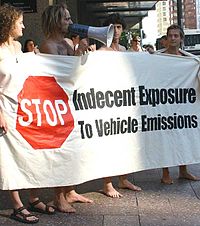 Demonstrators gathered outside a courthouse on 17 February 2005 to protest against the arrest of Simon Oosterman (second from left), Auckland's 2005 WNBR organiser
Demonstrators gathered outside a courthouse on 17 February 2005 to protest against the arrest of Simon Oosterman (second from left), Auckland's 2005 WNBR organiser
The ride has been criticized by some because WNBR largely involves participants who are naked or topfree. Some who are offended by nudity or topfreedom believe that it should take place in designated areas or times only, and that WNBR participants seek to engage in exhibitionism or even express sexually deviant intent.
Participants claim that non-sexualized, colorful and creative nakedness in repressed societies is a refreshing way to remind people of some fundamental freedoms of life that people have collectively handed over without really thinking of the consequences. They claim that the WNBR is about body-positive values: living a healthy life in tune with, not against, the environment; respecting the natural beauty and diversity of human bodies; establishing and projecting a positive self-image; and rejecting shame. Organizers feel that WNBR is not just a ride against oil dependency; it is a ride for self-empowerment.
Legality of public nudity
The policing of the ride varies according to local laws, local police policy, and local cultural expectations. At some events, police support and facilitate the event. Police have provided traffic control at road junctions for the London (until 2009), Brighton and Portland, Oregon rides. At other events police take a more neutral stance, simply monitoring proceedings. In other cases, such as in Ottawa,[4] police have attempted to stop the ride or have attempted to encourage riders to wear some level of clothing.
Arrests and charges
Arrests during WNBR events are rare. Two male riders were arrested during the 2005 WNBR in North Conway, New Hampshire, and charged with "indecent exposure and lewdness". The two riders agreed to having the charges reduced to "disorderly conduct" and paid a $300 fine, a major portion of which was paid for by the WNBR Legal Defense Fund.[5] Six male riders were charged with public indecency during the 2005 WNBR Chicago ride and later prosecuted with sentences ranging from fines and non-expungeable conviction to three months of court supervision.[6] During the WNBR held on 12 June 2010, two males were arrested by campus police at Western Washington University in Bellingham, Washington.[7]
WNBR's successful cultural and legal precedent
I have had many fun encounters with police officers; one of the most interesting was when this grumpy police officer came up to me and told me that he thought that what I was wearing was indecent. I looked him straight in the eye and told him that I thought his opinion was indecent. I was right; and no, I was not arrested.—Conrad Schmidt, speaking in Vancouver. Body painting is popular at the WNBR
Body painting is popular at the WNBR
The majority of WNBR events have encountered few cultural and legal problems.
Laws on nudity are often vague and difficult to enforce. As WNBR is clothing-optional, organizers urge those who are uncomfortable going naked or who fear legal scuffles simply not to go fully nude. Participants have used body paint, liquid latex, strategically placed items, underwear and duct tape to cover intimate parts. For example, flesh-colored bodysuits with exaggerated body parts were used in Seattle in 1999 by Fremont Arts Council members to spoof the Solstice Cyclists in the Summer Solstice Parade. Organizers encourage creativity and imagination, whether the participants go fully nude or not.
Some cities have restrictions on nudity in public areas, and some cultures have harsh restrictions on public nudity. However, the laws of most progressive societies are written to discourage activities which are intended to shock or offend. Many laws on nudity hinge on a concept of indecent exposure. Participants may argue that there is nothing indecent about the naked human body and counter that the only thing that is indecent are laws on nudity.
Simon Oosterman, the organizer of the 2005 WNBR in Auckland, and the first to be arrested during a WNBR event, is credited with going further and refocusing the issue on oil-dependency. He urged: "Stop the indecent exposure to vehicle emissions."[8] Oosterman later defended a charge of indecent exposure in the Auckland district court in 2006; after hearing evidence, the judge dismissed the charge.
 Bicycles are not necessarily the only form of travel used; this in-line skater is pictured at the 2010 WNBR in London
Bicycles are not necessarily the only form of travel used; this in-line skater is pictured at the 2010 WNBR in London
Riders are encouraged to "ride loud and be proud". Organizers only allow rides to be organized in public areas for maximum outreach, not in established or ghettoized areas. Events are promoted at the grassroots level, often using Internet resources such as discussion groups, web sites, blogs and online journals and also by placing advertisements in local, non-mainstream newspapers and progressive journals.
Further reading
- Sustainability and Cities: Overcoming Automobile Dependence (Paperback) by Peter Newman, Jeffrey Kenworthy (Island Press, February 1999) ISBN 1-55963-660-2
- The Offense of Public Nudity by Mark Storey
Films
- World Naked Bike Ride (31 min, UK, 2006) directed by Johnny Zapatos of High Altitude Films, narrated by Jon Snow.
- Indecent Exposure to Cars: The story of the World Naked Bike Ride (external link), produced by Conrad Schmidt
See also
- World Naked Bike Ride Seattle
- Individual and political action on climate change
- Bohemianism and counterculture
- Critical Mass
- Culture jamming; Direct action; Flash mob; Smart mob
- List of places where social nudity is practised
- Nakukymppi
- Naturism
- Nude beach and nudity in sport
- Nude recreation
- Public nudity
- Reclaim the Streets
- Soft energy path
- Utility cycling
- World Carfree Network
References
- ^ a b c Official WNBR global web site circa June 2004
- ^ Artists for Peace/Artists Against War, a non-profit group in Vancouver popularized the motto "Bare as you Dare" and "Naked Bicycle people power" during their Naked Bike Rides in 2003 that led up to and became early models for WNBR.
- ^ Artists for Peace/Artists Against War's archived web page is currently hosted by The Work Less Party of British Columbia
- ^ http://www.ottawacitizen.com/travel/Ottawa+bike+ride+naked/4932584/story.html "Ottawa bike ride not-so naked"
- ^ More information about the case can be found at WNBR North Conway website
- ^ Information obtained directly from Joseph Lawrence, one of those charged in the WNBR Chicago 2005 ride.
- ^ see http://www.bellinghamherald.com/2010/06/14/1479718/whatcom-county-jail-report-for.html
- ^ Simon Oosterman printed this on a protest banner as documented on Enzyme's WNBR web site
External links
Official links
- World Naked Bike Ride official site – general information and other resources
- World Naked Bike Ride wiki site – lists upcoming and past events, provides information for joining existing and creating new rides
- World Naked Bike Ride in Greece World Naked Bike Ride in Greece (Thessaloniki)
- [1] World Naked Bike Ride in Wales (Cardiff / Caerdydd)
Videos and pictures
- San Francisco Naked Bike Ride (SF Weekly photo set)
- Bikewars (London and Brighton Photos 2009)
- LONDON NAKED BIKE RIDE 2009 (LONDON PIXELS photo set)
- London Naked Bike Ride 2008 (LONDON PIXELS photo set)
- World Naked Bike Ride (WNBR) (Brighton photos, 2008)
- World Naked Bike Ride (WNBR) (Brighton photos, 2006)
- The World Naked Bike Ride (31 minutes, 2006, UK) by Johnny Zapatos of High Altitude Films - The story of the first World Naked Bike Ride to take place on the streets of London (4 parts)
- Pictures of the World Naked Bike Ride on Flickr
- You Never Bike Alone - Feature documentary includes section on WNBR history
- Miami Beach Police say nude cycling is not allowed
- 2006 WNBR Seattle Photos
- 2004 WNBR Seattle Photos
- [2] Police in São Paulo - Brazil committing abuse against a rider in WNRB
- WNBR London 11 June 2011 - Start Hyde Park Video
News
- Biking Revolution News Toolbar News about World Naked Bike Ride, Critical Mass, & Super Hero Service Rides.
- "London Naked Bike Ride, Bike Riders Strip Naked in Protest London Naked Bike Ride, Bike Riders Strip Naked in Protest". Thecurrentaffairs.com. http://mumbainews.info/london-naked-bike-ride-bike-riders-strip-naked-in-protest. Retrieved 2010-07-13.
Categories:- Naked cycling events
- History of cycling
- Recurring events established in 2003
Wikimedia Foundation. 2010.

